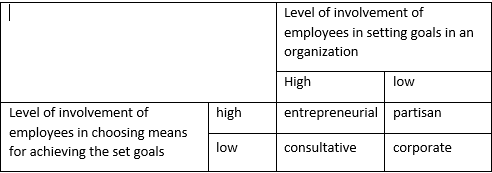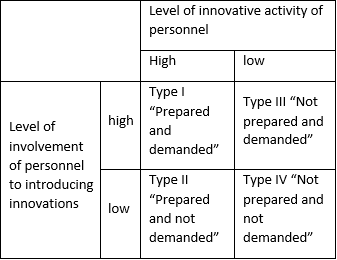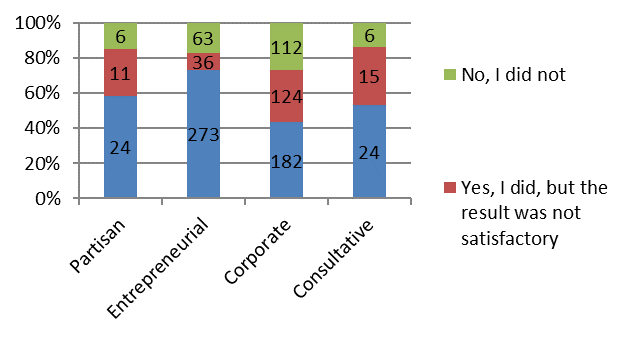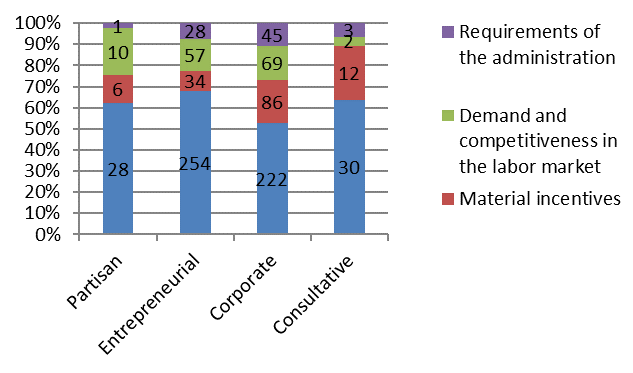Abstract
The dynamic innovative processes require activating the intellectual and creative potential of employees. The key issue is developing the organizational culture, not so much influencing the employees’ preparedness for innovative activity as providing them with opportunity to implement their potential. Our research is based on the polling of 1004 employees from 17 medical establishments in the Republic of Tatarstan. The obtained data were aggregated and used as a database analyzed with SPSS Statistics software. In compliance with the author-designed methodology, the employees were divided into four typological groups by their preparedness and ability for innovative activity: prepared and demanded (type I), prepared and not demanded (type II), not prepared and demanded (type III), not prepared and not demanded (type IV). This classification was referred to the types of organizational culture by R. Ackoff. We found that two types of organizational culture prevail in medical establishments of the Republic of Tatarstan – corporate and entrepreneurial. In the establishments with entrepreneurial organizational culture, employees of type I prevail, while in the establishments with corporate culture – employees of type II. At the same time, the medical establishments of entrepreneurial type show a more developed scientific and innovative activity of the personnel. An innovatively active employee may not only develop themselves but also develop the existing model of organizational culture. In the medical establishments with corporate organizational culture, employees demonstrate the lowest level of scientific-research activity.
Keywords: Organizational cultureinnovative behaviorinnovationspreparedness for innovationscorporate culture
Introduction
The global digital trends of world economy development cause significant changes in approaches and conceptions of human resources management. The new approaches to human resources management at institutions and business entities are focused at building efficient forms of interaction between employees. They are aimed, first of all, at correcting the internal and external motivation of the personnel through developing an integral organizational culture. This leads to maximal involvement of the personnel into implementing the economic, production, research and technological aims of the institution, as well as to solidarity and cooperation of the employees.
The dynamic innovative processes require activation of intellectual and creative potential of the employees. In this regard, the mechanism of employees motivation should be viewed as a complex, multi-aspect process of employing the inner motives (intrinsic motivation) and developing additional external incentives (extrinsic motivation) for their inducement ( Kovalenko, 2019).
Problem Statement
Generally speaking, one should note that a great number of note scientific publications highlight the need for interaction between internal and external motivation as a means of managerial impact on the employees’ innovative behavior ( Kovalenko, 2019). At the same time, many scholars believe that material incentives of the employees’ innovative activity either have a minor short-term effect ( Grosheva & Naumkin, 2012) or are counterproductive ( Andersen, Murphy, & Borsch, 2016). This was confirmed by Lofi and Rost ( 2014), who showed a negative impact of financial reimbursement on the employees’ innovative activity.
The need for comprehensive application of employees’ social stimulation (through corporate culture) for implementation of their preparedness for innovations was shown in the works by Bеlkin, Bеlkina, and Antonova, ( 2018). They focused not on the employees’ preparedness for innovations, but on the opportunities granted for them to implement their activity. According to the researchers, such opportunity only occurs in those organizations where the value orientations of innovative activity are introduced into corporate culture. Development of corporate values and their introduction into the organizational culture are an essential condition of implementing the innovative and creative activity of the personnel.
The truly innovative behavior of the personnel is characterized not only by their ability to generate knowledge and creative ideas. At the same time, it requires the employee’s preparedness, in case of availability of the appropriate opportunities, to implement the said actions, i.e. to introduce the results of their activity into practice. This requires the adequate innovation-oriented organizational culture, which develops and maintains the conditions for revealing the intellectual and creative potential of the employees ( Sinyakov, Khomutskiy, & Lezhneva, 2012). The innovative organizational culture is the working environment which motivates the personnel and makes them feel assured that their efforts in creating new products or services would be supported and encouraged. The powerful organizational culture facilitates the maximal involvement of employees into the labor process, based on each employee’s awareness of their personal contribution and value of the work performed ( Mironova, 2019). The organizational culture forms devoted personnel, committed to the common set of values ( Blanshar & О'Connor, 2003) motivated for reveling their potential, effective work, and desire to get maximal result for achieving the institution’s strategic goals.
Such significant impact of innovative organizational culture is due to its orientation towards employees’ cooperation. The employees find it easy to turn to colleagues for help, even if their job descriptions do not oblige them to help each other. The employees feel collectively responsible for the common business ( Pisano, 2019). On the contrary, if the existing organizational culture makes employees fear criticisms, openly doubt their boss’s words, contest other people’s ideas, and propose their own, there would hardly be innovations in such environment ( Pisano, 2019).
An empirical research of small businesses sector in Malaysia made the authors conclude that all aspects of organizational culture (adaptability, involvement, mission, and succession) significantly influence the employees’ innovative behaviour ( Abdul-Halim, Ahmad, Geare, & Thurasamy, 2019).
Similar opinion was expressed by Danish, Asghar, Ahmad, and Ali ( 2019), who concluded that openness for changes and self-efficiency of employees have a positive influence on the entrepreneurial culture.
In her research of the impact of corporate culture on creative and innovative potential of the personnel in Russian companies, Endovitskaya ( 2020) comes to the conclusion that there is a certain misbalance. Strong corporate traditions often consist in a significant flow of social benefits granted by an employer, while the employees’ creativity is limited, innovations and technological progress are lacking. This misbalanced corporate culture is also manifested in poor management of improving the personnel qualification. On the other hand, emphasis on innovations, improving qualification and creativity of the employees, characteristic for one of the analyzed companies, actually led to forming a misbalanced corporate culture.
According to Ilyinykh and Mikhailova ( 2015), the factors significantly influencing the implementation of the employees’ innovative potential are competence, career growth prospects, and fair reimbursement of each employee in compliance with their merits. By the results of their research in small businesses, competence was highlighted by 75.1% of the respondents, career growth prospects after implementation of innovative projects – by 78.9%, and reimbursement in compliance with the merits of each employee – 85.2% of the respondents.
When researching the determinants of organizational culture, influencing creativity and innovations, Martins and Terblanche ( 2003) identified the most significant of them – general strategy and structure of the organization, mechanisms of supporting the innovation-oriented behavior, and open communication between colleagues and management. The values, norms and views forming the organizational culture may either facilitate or impede creativity and innovations by influencing the individual and group behavior of the employees.
Classification of organizational culture by Ackoff ( 1999) uses two criteria for determining the types of organizational culture:
level of involvement of employees in setting goals in an organization (low, high);
level of involvement of employees in choosing means for achieving the set goals (low, high).
As a result, he got four types of organizational culture: corporate, partisan, entrepreneurial, and consultative.

The corporate type of culture is characterized by autocracy. This type of culture is traditionally inherent in managed corporations with centralized structure. The partisan type of culture applies autonomous relations. This type of culture is, as a rule, used by cooperatives, creative associations, clubs, etc. The entrepreneurial type of culture is distinguished by its democratic relations. Organizations managed by goals or results, as well as organizations with the “reverse pyramid” structure often adhere to this type of organizational culture. Organizations with consultative type of culture are characterized by “doctor-patient” type of relations. This type of organizational culture is used at medical and educational establishments, social and other services institutions.
Research Questions
The authors attempted to identify and classify certain groups of personnel from the viewpoint of their preparedness and ability for innovative activity. The identified types of personnel were correlated with the known types of organizational culture of institutions (by R. Ackoff’s classification). Then, the general and specific features of various types of innovative activity of personnel were revealed, depending on their belonging to a certain type of organizational culture of medical institutions.
Purpose of the Study
The objective was to define the features of innovative behavior of personnel and methods of their stimulation under various organizational cultures.
Research Methods
The key method of information accumulation was polling. It was carried out from February to May 2019 in healthcare establishments of the Republic of Tatarstan. The polling included 1004 employees of 17 medical establishments. According to the data of Tatarstan Statistical Agency as of 1 January 2018 (the recent data), the annual average number of people employed by healthcare and social service establishments was 100.2 thousand people ( Abdul-Halim, Ahmad, Geare, & Thurasamy, 2019). The sample with a minimal probability of statistical error (under confidence probability of 99% and error of 5%) is 661 people. Thus, the sample is representative.
The research was carried out in the form of questioning. The questionnaire contained both close and open questions, and ranking tasks. Questioning was anonymous. The data were integrated into a single massif and analyzed as a single base with STATISTICA 12 and SPSS Statistics software.
Findings
Women (85.6%) have the largest unit weight in the structure of the polled personnel (Table

The differences in the number of personnel in Tables
Most of the employees referred the organizational culture of their medical establishments to the corporate type, characterized by autocratic relations. The largest unit weight of type I employees is characteristic for the establishments with entrepreneurial type of organizational culture; of type II employees – for the establishments with consultative type of organizational culture; of types III and IV – for the establishments with corporate type of organizational culture.
At the next stage of our research, we reveal the differences in the level of scientific-research activity in terms of the distinguished groups of personnel (Table
The predictably high level of research activity is observed in personnel of types I and II by the author’s classification.
Employees of the establishments with corporate type of organizational culture demonstrate the lowest level of scientific-research activity. 96% of them do not carry out research; hence, they are not motivated to study and introduce new advanced methods and techniques of diagnosing and treatment. At the same time, every fifth employee of the establishments with entrepreneurial type of organizational culture, which are characterized by democratic relations, carries out scientific research, studies scientific publications on special topics and issues. Such employees are able to not only develop themselves but also develop the existing model of organizational culture. In the establishments with entrepreneurial type of organizational culture, many employees consider that their management is interested in traineeship of the personnel (59.3% of type I and 44.9% of type II), while in the establishments with corporate type of organizational culture, their share is, on the contrary, low – 19.9% and 13.2%, respectively.
The efficiency of employees’ participation in advanced qualification programs is also different for various types of organizational culture.

Some employees (21 people) could not answer this question.
Fig.
One third of the employees of partisan and consultative type of organizations marked the low level of results after passing advanced qualification courses.
About 72% of the employees of the establishments with entrepreneurial type of organizational culture mark that advanced qualification courses and traineeship contribute to the development of their professionalism. In our opinion, the organizational environment of such establishments creates conditions and stimuli for the personnel development. Our conclusions indirectly confirm the answers to the question about stimuli for improving qualification.

Thus, almost 70% of the employees of the establishments with entrepreneurial type of organizational culture mark their desire to develop their personal professionalism as the main goal of taking advanced qualification courses. In the establishments with corporate type of organizational culture, the stimuli are primarily requirements of the administration and material incentives.
Further we consider the preparedness of the personnel to use the knowledge and skills of their colleagues at work and to share the knowledge and skills with them. Analysis shows that there is no significant difference the preparedness of the personnel to use their experience and to cooperate with their colleagues. Thus, 98% of the employees of medical establishments with entrepreneurial type and 94% of the employees of medical establishments with corporal type of organizational culture are ready to use the knowledge and skills of their colleagues at work; 97.6% and 95.3%, respectively, are ready to share their knowledge and experience.
Conclusion
Based on the polling of employees of medical establishments, this research identifies the types of organizational culture, according to approach by R. Ackoff. The medical establishments of the Republic of Tatarstan mainly form organizational culture of two types: corporate (47.3%) and entrepreneurial (42.3%). In each of the four groups, we distinguish types of personnel depending on the level of innovative activity and involvement of employees in introducing innovations, in compliance with the author’s approach. 56.7% of the employees of medical establishments with corporal type of organizational culture are “prepared and demanded” by their administrations for introducing innovations, 32% are “prepared and not demanded”. In the establishments with entrepreneurial type, they are represented as 73.5 and 23.4%, respectively. The largest share of employees of type I is characteristic of the establishments with entrepreneurial type of organizational culture; the employees of type II are characteristic of the establishments with consultative type of organizational culture.
The medical establishments with corporate type are marked with the low level of scientific-research activity of the personnel (4%). Organizations are not interested in traineeship of their employees at Russian and foreign clinics. The personnel are poorly involved in advanced qualification programs, and the efficiency of their participation is low. The stimuli for improving qualification of 30% of the employees are material incentives and demands on the part of administration.
In the medical establishments with entrepreneurial type, the level of scientific-research activity is high (19.4%). About 55% of the employees mark that administration is interested in their participation in traineeship. Most employees consider their participation in advanced qualification programs to be efficient. For such employees, the main stimuli for improving qualification are personal professionalism and positions in the labor market. They are ready to share and use the knowledge and experience of their colleagues in professional activity.
Acknowledgments
The reported study was funded by RFBR according to the research project №19-010-00251 А.
References
- Abdul-Halim, H., Ahmad, N. H., Geare, A., & Thurasamy, R. (2019). Innovation Culture in SMEs: The Importance of Organizational Culture. Organizational Learning and Market Orientation. Entrepreneurship Research Journal, 9(3), 10.
- Ackoff, R. L. (1999). Re-creating the Corporation: A Design of Organizations for the 21st Century. Published by Oxford University Press, New York, USA.
- Andersen, N., Murphy, T., & Borsch, A. (2016). Nothing for money: Behavioral perspective on innovation and motivation. Deloitte Review, 18, 71-85.
- Bеlkin, V. N., Bеlkina, N. A., & Antonova, O. A. (2018). Stimulirovaniye innovatsionnoy aktivnosti personala na osnove korporativnoy kultury [Stimulating innovative activity of the personnel based on corporate culture]. Diskussiya, 88, 28-37. [in Rus.].
- Blanshar, K., & О'Connor, М. (2003). Managing by Values. How to Put Your Values Into Action for Extraordinary Results. Berrett-Koehler Publishers, San Francisco, USA.
- Danish, R. Q., Asghar, J., Ahmad, Z., & Ali, H. F. (2019). Factors affecting “entrepreneurial culture”: the mediating role of creativitу. Journal of Innovation and Entrepreneurship, 8(1), 14.
- Еndovitskaya, E. O. (2020). Development of Corporate Culture Stimulating Innovation and Creative Capacity of Staff. Lecture Notes in Networks and Systems, 73, 1131-1138.
- Grosheva, E. P., & Naumkin, N. I. (2012). Motivatsiya innovatsionnoy aktivnosti [Motivation of innovative activity]. International Journal of Applied end Fundamental Research, 2. [in Rus.]. Retrieved from http://www.science-sd.eom/pdf/2012/2/Grosheva.pdf
- Ilyinykh, S. A., & Mikhailova, E. V. (2015). Innovatsii v organizatsiyakh: vnedreniye i protivodeystviye [Innovations in organizations: introducing and resisting]. Sotsiologicheskiye issledovaniya, 6, 86-90. [in Rus.].
- Kоvalenko, А. А. (2019). Innovatsionniy menedzhment: razvitiye modeli motivatsii innovatsionnoy aktivnosti predpriyatiya [Innovations management: developing a model of motivation to innovative activity of an enterprise]. Gosudarstvennoye upravleniye, 72, 248-274. [in Rus.].
- Lofi, Z., & Rost, K. (2014). Pay-for-Performance for Top Managers and Innovation Activities in Firms. Druid Society Conference. Copenhagen: CBS.
- Martins, E. S., & Terblanche, F. (2003). Building organizational culture that stimulates creativity and innovation. European Journal of Innovation Management, 6(1), 64–74.
- Mironova, N. A. (2019). Sistema upravleniya personalom na sovremennom predpriyatii [System of personnel management at a modern enterprise]. Mosckovskiy ekonomicheskiy zhurnal, 7, 649. [in Rus.].
- Pisano, G. (2019). Creative Construction: The DNA of Sustained Innovation. HARVARD BUSINESS REVIEW. Retrieved from https://hbr-russia.ru/innovatsii/upravlenie-innovatsiymi/794907
- Sinyakov, V. N., Khomutskiy, D. Yu., & Lezhneva, N. V. (2012). Koleso innovatsiy [Wheel of innovations]. Moscow: Poligraficheskiye masterskiye. [in Rus.].
Copyright information

This work is licensed under a Creative Commons Attribution-NonCommercial-NoDerivatives 4.0 International License.
About this article
Publication Date
12 March 2020
Article Doi
eBook ISBN
978-1-80296-079-2
Publisher
European Publisher
Volume
80
Print ISBN (optional)
-
Edition Number
1st Edition
Pages
1-483
Subjects
Information technology, communication studies, artificial intelligence
Cite this article as:
Kabasheva*, I., Rudaleva, I., & Gorbatov, A. (2020). Innovative Behavior Of Personnel In Institutions With Various Organizational Cultures. In O. D. Shipunova, V. N. Volkova, A. Nordmann, & L. Moccozet (Eds.), Communicative Strategies of Information Society, vol 80. European Proceedings of Social and Behavioural Sciences (pp. 170-179). European Publisher. https://doi.org/10.15405/epsbs.2020.03.02.21
